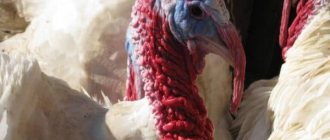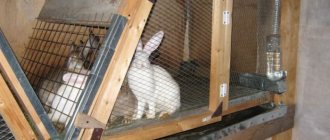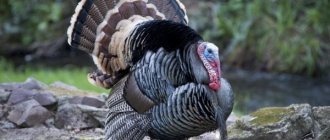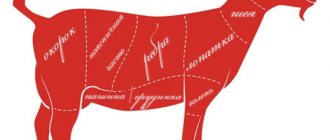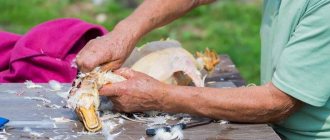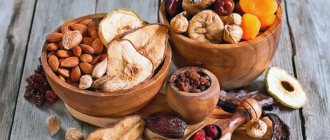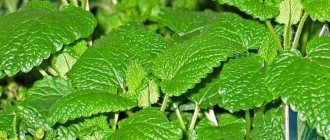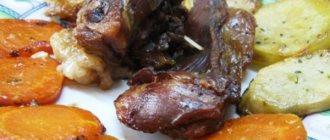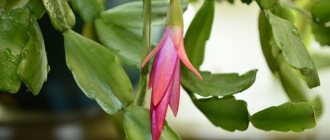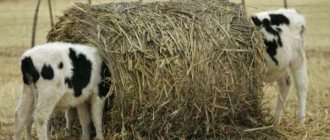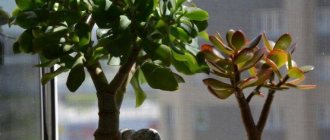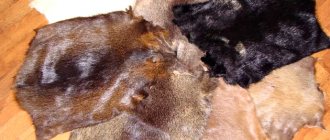September 8, 2017 Vladimir Khomyakov
Correct slaughter
Dear friends, I have been putting off writing an article for a long time on a topic that, although important, is associated with a certain degree of cruelty towards our favorite rabbits. The reality is that sooner or later, any rabbit breeder who deliberately started his own meat, skin or down farm is faced with an inevitable stage of his activity - the slaughter of animals.
THE FOLLOWING MATERIAL is not intended for children, representatives of the Green Party and animal rights groups, as well as those who are overly impressionable and look at their pets solely as family members, and not as a source of additional income. There are other interesting articles and entire sections on the site especially for you.
Carcass processing
The legs and ears are separated using a circular knife: the front legs are cut off at the carpal joint, and the ears and tail are cut off at their very base.
Whitening (skin incision or marking of skin removal lines) and removal of skins. When removing skins with a tube, a circular incision is made around the hock joint of the hind legs, then from the hock joint of one hind paw to the other, an incision is made along the inside of the lower leg and thigh, in the middle of the anus. After the incision, the skin is removed from the hind legs, then from the tail to the head to the front legs. , without allowing it to be damaged, without using a knife, release the front paws, and carefully cutting around the eyes, nose and lips, remove it from the head. When slaughtering rabbits with the head cut off, the skin is whitened and removed in the same sequence, with the exception of the operation of removing the skin from the head
When the blood has completely drained, the rabbit is hung by the hind legs with twine to the rail so that the limbs are separated by 30 cm, and the body (tail) is at the level of your shoulders. Lay an oilcloth on the floor under the carcass and place a basin for the entrails.
Using a sharp knife (it is better to have two knives on hand - one for skinning, the other for cutting the carcass), make circular cuts around the hocks, along the inside of the legs to the anus, where both cuts connect
Then grab the edge of the skin with your thumb and forefinger and, pulling it back and carefully trimming it, separate it from the carcass with a knife
Use the knife carefully, avoid cutting the skin, as each cut reduces the grade. Experienced rabbit breeders use a knife only when removing skins from the paws and head.
Be especially careful with the knife when you reach the front paws. Having released them, pull them up with twine so that they do not interfere when removing the skin from the head.
Having reached the ears, trim the cartilage and continue skinning. After removing the skin, remove the ear cartilage, pull it onto a straightener. Tie the ends of the skin of the hind paws tightly with twine to the slats so that the skin does not fall off the straightener, and hang to dry. Do not try to over-tighten the skin on the straightener, this will lead to thinning of the fur.
Nutrovka
After slaughter and removal of the skins, the evisceration begins. To open the abdominal wall, an incision is made along the white line from the anus to the chest, after which the urinary and gall bladders are removed, cutting them off with a knife. The pubic symphysis is cut, the rectum is separated from the muscles and the intestines, stomach are removed, and then the liver, heart, lungs, trachea, esophagus, kidneys along with kidney fat remain with the carcass. The head is cut off between the occipital bone.
A cut along the white line allows you to easily remove the rabbit skin
When gutting carcasses, a veterinary and sanitary examination is carried out - examination of the muscles of the head, carcass and internal organs
During examination, pay attention to the presence of pathological changes, the degree of bleeding, and the quality of treatment.
Cleaning and shaping carcasses
Dry and wet stripping of carcasses are common. Dry stripping involves removing bruises, bruises, bruises, as well as hair and skin residues from carcasses. Then they begin wet stripping - removing mechanical contaminants and microorganisms from the surface of the carcasses with warm water (25-30 C) using a shower device.
Carcasses are molded to give them a compact shape and marketable appearance. To do this, incisions are made on the sides of the chest between the third and fourth ribs and the ends of the front legs are inserted into them. The ends of the hind legs are connected through punctures in the hock joints and turned to the outside.
The skin of a rabbit is removed with a stocking
Formed rabbit carcasses are sent to the cooling room at a temperature not exceeding +100 oC, being in a vertical position. Rabbit carcasses are considered cooled if the temperature in the thickness of the thigh muscles is not higher than 25 C, chilled if the temperature in the thickness of the thigh muscles is 0- +40 ° C, frozen if the temperature in the thickness of the thigh muscles is not higher than -60 C.
Main stages of cutting
To avoid disappointment in rabbit farming, you need to know how to properly butcher a rabbit, because they are usually kept in large quantities, and the time spent on slaughtering and butchering them should be as little as possible. In addition, the condition of the meat depends to some extent on this knowledge.
When you plan to sell rabbit meat, you should pull the rabbit out of the cage strictly by the ears, since if you grab it by the withers or other places, then after skinning the carcass, bloody streaks and bruises will remain on the meat. After slaughter, it must immediately be hung on hooks, and it is not at all necessary to pierce the paws, just put the leg into the hook and it will be securely fixed there.
After slaughter, the carcass must be bled , that is, the arteries in the neck must be cut. The incision is made clearly in the middle of the neck, while during the dissection of the neck tissue the head is moved slightly to the side. After blood appears, you should make sure that all vessels are cut. Bleeding of the carcass occurs within one to two minutes, then you can begin to remove the skin. The exact time when you can peel it is also determined by the tail: if it is completely drooping, then you can start cutting.
Spacer-hanger
To make it convenient to remove the skin from a killed carcass, it is hung on a spacer hanger.
A hanger-spacer is more convenient not with piercing pins, but in the form of a frame. Then the rabbit’s legs are not strung on pins, but spread apart and inserted into the slots. It's more convenient and faster. How to make such a frame is shown below.
The figure shows all the dimensions required for manufacturing. It is made from available metal material at hand. Therefore, your measurements may vary. But the main principle of operation is clear. According to this scheme, the distance between the spread paws is 145 mm. This is not enough. It is better if it is 200-250 mm.
Features of skinning
Anyone who has never experienced skinning a carcass is unlikely to know how to skin a rabbit. There are several removal techniques. These include:
- stocking removal;
- layer;
- tube.
Usually, to skin rabbits, they use the stocking method. First, part of the skin is cut off on the inside of the hind legs, after which a small middle part and tail are removed. You need to cut carefully so as not to damage the meat. Then the skin from the hind legs is completely removed with the fingers.
The ears are cut off at the very base. It is better to cut them off not one at a time, but two at once. After the ears come the front paws and at the end the entire skin is removed all the way to the front paws. In this area you will have to cut some places, including the tendons of the front legs. When removing in the head area, if necessary, it is necessary to trim the area of the eyes and nose.
Skin dressing
For preservation, the stretched sheets of skin removed from the rabbit and peeled must be preserved immediately by covering it with salt. All folds and edges are carefully straightened. If several paintings are placed nearby, they are moved away from each other so that they do not touch.
Tools for dressing rabbit skins.
Rulers with prepared skins are left in a dry and dark, well-ventilated place until the canvases are completely dry. If the room is damp, very cold, or vice versa too hot (more than 30 ℃), the raw materials may deteriorate. The average drying time is about 24 hours. After this, the wool is combed, and the inner surface, if necessary, is additionally cleaned.
Removing animal entrails
Before starting the cutting process, be sure to wash your hands so that the meat is clean and does not get dirty with hair that can stick to your hands. A small incision is made on the rabbit's chest, two fingers are inserted into it and the tissue is pulled apart. After this, a knife is inserted between the fingers and an incision is made to the pelvic area. This is done in order not to damage the bladder and intestines.
It is necessary to make an incision between the legs and spread them apart until a crunch appears. Then he prys it up with his fingers, tears it off and lowers the rectum. All lymph nodes must be cut off, the gonads removed, and the insides, except the liver and heart, removed. The gallbladder must be removed from the liver, and it must be cut off along with a piece of the liver, otherwise it will be damaged. The head is cut off last at the base of the neck.
If there is some fluff left on the skinned carcass, you can remove it with your hands, previously soaked in water. If necessary, you can additionally wipe the meat with a dry cloth.
How to properly slaughter a rabbit
As already noted, rabbits can be slaughtered without special skills. Everything you need to know about how to slaughter a rabbit at home is reflected in the following steps:
First you need to calm your pet and pick him up. After he has relaxed, you can kill him. To do this, you need to grab the pet by the hind legs with your second hand and hold tightly until he stops struggling. Using a previously prepared stick, a blow is struck to the back of the head. The brain is located there, so the blow must be accurate. However, the force of the blow should be calculated, since a blow that is too weak will not kill the rabbit immediately, but will make it struggle, make sounds, and suffer for a long time. That is, the blow with a stick is applied strongly and accurately. After this, the carcass is hung on a stick to drain the blood from the dead person. To do this, two cuts are made on the hind legs. A stick is inserted into these holes with sharp ends. Blood will come out if you cut an artery in the throat, cut the skin in the nose, or remove the eyeballs. A sharp knife will help you do all this.
Note: it is important to drain the blood completely, because this will make the meat and skin better quality.
The sequence of these actions, which is resorted to when slaughtering domestic rabbits, is mechanical. This method is typical, as a rule, for small farms.
Industrial enterprises and large farms use another method of slaughter - electric shock to the temple area. In this case, it is possible to drain the blood better.
An alternative method used in the process of how to kill a rabbit is the so-called French approach. It consists in the fact that the pet dies from rupture of blood vessels. To do this, the rabbit is placed on a flat surface.
Then the ears are taken in one hand and the paws in the other. You should wait a little for the pet to calm down and stop struggling, and then pull your hands in different directions. Let us note that the choice of which method of slaughter is more humane lies on the shoulders of the rabbit breeder himself.
Removing the skin
After the rabbit has been slaughtered, the skinning process begins, that is, removing the skin. To do this you will need a sharp knife. They need to rip the area from the tail to the inside of the hind legs. The area surrounding the feet is also cut, but the tips of the paws are not separated from the skin.
For cutting, cuts are made between the thigh parts to easily pull the skin over the groin area. There is no need to remove the skin from the latter. Now the skin is removed all the way to the head part.
When removing the skin, you should be careful to cut off individual pieces of skin incorrectly. As a result, the skin should be removed entirely and not have any major damage.
After all these manipulations, you should pay attention to how to cut a rabbit
Cutting up a rabbit carcass
How to properly butcher a rabbit? For work, take a sharp knife. First you should get rid of the organs of the reproductive system and bladder.
Then the gastrointestinal tract organs are cut out, this will be helped by the groin area, where the skin was not cut out. After this, the liver and gall bladder should be removed. When butchering a rabbit, at the final stage you need to cut off the head part.
After removing the entrails, the carcass is removed from the frame and the limbs are cut off. Once these steps are completed, we can say that the cutting of the rabbit is completed.
Bleeding and flaying
After slaughter, a bleeding procedure is carried out. The rabbit carcass is hung by its hind legs over a container upside down to collect blood. Next, the head of the killed animal is cut off between the back of the head and the first cervical vertebra or the jugular veins are cut. Both methods work great to drain all the blood in less than 5 minutes. After bleeding, skinning is carried out - removing the skin from the body. You need to peel the skin while still warm so that it is smoother and it is easier to stretch it on the spacer.
Before skinning, you need to wash off the dirt and blood residue from the fur and comb the fur. They begin to skin the carcass from the hind legs using a sharpened knife. The fur near the hind legs is cut in a circle, then an incision is made from paw to paw in the center of the anus. The rabbit skin turned inward is slowly pulled down to the forelimbs. If areas of strong tendons and fatty deposits are found, they are carefully cut with a knife.
Then the hair near the front paws is carefully cut out. Be careful not to damage the fur. They also carefully cut out the skin around the eyes, nose, lips, and then completely remove it from the head. If the head was cut off during slaughter, then the skin is whitened and removed in the same way, but the last stage (cutting holes in the head) is no longer needed. After the rabbit has been skinned, its skin is stretched onto a pre-prepared spacer.
industrial rabbit slaughter
3 years ago
Rabbit slaughter line Italy, Impianti
Italian-made rabbit slaughter line. Most of the operations are performed manually. Provided...
7 years ago
UralMiakro. Rabbit slaughter and processing station
Slaughter and processing point for rabbit meat at the Ural-Miakro enterprise. Yekaterinburg city. Cordon sanitaire, story...
1 year ago
device for slaughtering rabbits detailed review
Thank you for watching our channel. It’s very easy to help the channel: ➀ Subscribe to the “Russian Ranch” channel and click...
1 year ago
Rabbit slaughter training video home mini slaughterhouse
Training video: Slaughtering and butchering a rabbit at home, a convenient mini slaughterhouse for rabbits. Slaughter...
4 years ago
Training video: Slaughtering rabbits at home in 1.5 minutes. LPH Sakhon
How to organize a mini-slaughterhouse for rabbits with a productivity of 1.5 minutes per slaughter of one rabbit in domestic...
3 years ago
Modular complex for slaughtering and processing rabbits 120 heads per hour
The Rabbit slaughter line with a capacity of up to 600 heads per shift allows processing carcasses weighing up to 6 kg….
8 years ago
Industrial rabbit slaughter
Additional information and prices on the website: https://valagro.ru Industrial slaughter of rabbits, the line is equipped with machines...
1 year ago
Rabbit slaughter! live weight and meat!
Weight of a 3-month-old rabbit before and after slaughter. Pure meat!!!
2 years ago
Chain and Lift Method
An investigation by PETA and Animal Rights Anonymous found that slaughterhouses exporting beef to Israel before...
7 years ago
Technology for slaughtering rabbits at the UralMiakro enterprise.
Training video on slaughtering rabbits Filmed at the point of slaughtering and processing rabbit meat at the Ural-Miakr enterprise...
6 months ago
CHOOSE A RABBIT for slaughter, weight of a rabbit for slaughter | Diary of a Rabbit Breeder #47 | Arbolitich
In this video I’ll talk about how I select rabbits for slaughter. Raising rabbits for meat is realized as...
4 years ago
Rabbit slaughter production line. Delivery from China
China-line - delivery of production lines from China. We will find the necessary industrial line in China, prepare all the documents...
7 years ago
Slaughterhouse Horror.avi
9 years ago
Automated line for slaughtering rabbits - 250 per hour
Automated rabbit slaughter line. Productivity 250 heads per hour. Automated slaughter line for rabbit. Capacity 250 per hour.
6 years ago
Poultry slaughter and primary processing
This video demonstrates the technological process of slaughter and primary processing of poultry, using technology…
2 years ago
Slaughter shop
Construction of turnkey rabbit farms, https://industrial-rabbit-breeding.rf.
10 months ago
Device for slaughtering pigs and cattle (Electric Stunner/Stunner)
Test of the new model of the stun gun "Boar V 2.0". For purchase - https://karpinstrument.com.ua/p730288666-transformator-dlya-oglusheniya.html.
2 years ago
slaughter and butchering of rabbit
If you want to help our channel, then: 1. Subscribe to the channel to stay updated on what’s happening….
4 months ago
Slaughter of 1 four young bulls
5 months ago
Slaughter of pigs at a state plant. Professional slaughter of livestock. How to slaughter Pigs training.
11 years ago
Industrial pig slaughter
Industrial slaughter of pigs is presented.
7 years ago
Pig slaughter in Italy and Russia
Additional information and prices on the website: https://valagro.ru Technologies for slaughtering and processing of pork in Italy....
7 months ago
Electrocuting a pig
I electrocute a pig (version without editing) in one shot. Pig slaughter https://youtube.com/embed/I3mJfu3kMro Device for...
5 months ago
Industrial slaughter of cattle
https://bsatu.by/ru/institut-povysheniya-kvalifikacii-i-perepodgotovki-kadrov-apk/uchebnye-videofilmy/pererabotka.
6 years ago
Industrial rabbit breeding. Maintenance and breeding
Keeping and breeding rabbits in industrial cages. Rabbit breeding enterprise Favorit-Agro LLC….
7 years ago
Industrial poultry slaughter
Additional information and prices on the website: https://valagro.ru Poultry slaughter line with a capacity of 8000 heads...
2 years ago
Rabbit slaughter. Rabbit slaughter line, hangers.
The productivity of the rabbit slaughter line is up to 200 heads per hour, depending on the number of slaughterhouse employees...
more (962+ videos)
What to do with the skin
Dressing rabbit skins is a technically quite complex and time-consuming activity. Here is an approximate order of this procedure:
- fat and veins are cleaned from the flesh;
- soaking is performed in a special solution;
- the skin is fleshed, that is, the fibrous tissue of the skin is loosened;
- the material is treated with a solution containing acid (picking);
- the skins are kept in piles under a load for about a day;
- tanning and fattening are carried out.
Do-it-yourself slaughter of rabbits on private farms and farms is practiced quite often. But skins for dressing are usually handed over or sold to enterprises specializing in this operation. In this case, after slaughter they must be preserved. To do this, after cleaning them from fat and veins, they are stretched on a special straightener for drying. Each skin must be carefully straightened. Otherwise, the flesh will gather like an accordion, and the fur will come out at the folds. You cannot delay the conservation procedure. Otherwise, the removed skins may rot.
So, how long does a rabbit grow before slaughter and how this procedure is carried out correctly, we found out. The simplest method of killing is to use a stick. If you have a large farm, you should use a pin. Use humane slaughter methods. If you do everything according to the rules, the carcasses will have a pink presentation in this case too.
How to determine the right time for slaughter
The time for slaughter is chosen depending on the tasks. If the only goal is to obtain dietary meat, then killing can be done on any day, provided that the animal has reached the required parameters.
Rabbits of early maturing broiler varieties (New Zealand white, Californian, chinchilla) are usually slaughtered for meat at the age of about 4 months; in some very large farms this procedure is carried out earlier - at 3-3.5 months, when the weight of the animals reaches from 2.5 to 2 .7 kg. At home, rabbits are usually kept until they are 5-6 months old, until they gain an average weight of around 3.5-4.5 kg. Representatives of giant breeds are raised to 6-9 months - the optimal slaughter weight is 7-8 kg (or more).
If not only meat is important, but also high-quality skin, certain nuances should be taken into account, mainly related to the size of the animals and molting. By slaughtering a rabbit ahead of schedule, the owner risks receiving low-quality products from which lint will fall out
In rabbits bred for skin, it is important to take into account the condition of the coat and molting periods
Seasonal molting begins with the onset of warm weather and ends in winter. Therefore, the optimal period for slaughter is from October to March. The age-related change in coat, depending on the breed, occurs at 6-8 months.
The completion of molting can be determined by several parameters:
- skin color - in areas where the process of hair change is completed, the skin is white, in other places it is dark (in breeds with white hair, skin color does not change, so this indicator is not the main one);
- hair strength - you should try to lightly pull out a few hairs in different places on the back and belly of the rabbit. If this can be done, then the coat change is not over yet. The fur should hold firmly.
Whole carcass
If you slaughter several rabbits at the same time and do not plan to cook them right away, then you can store the carcasses in the freezer. It is best to freeze whole rabbits - this way you will have the opportunity to prepare any dish in the future, even baking the whole carcass in the oven.
Experts say that you should never wash a rabbit before freezing it. Water quickly seeps into the fibers, disrupting the structure of the product, so such rabbit meat cannot be stored for long.
Before freezing, prepare meat as follows:
- Trim off pieces of fat (they shorten the shelf life).
- Scrape off dirt with a knife.
- Clean the carcasses with a cloth towel, while removing excess moisture from the meat.
- Prepare a room for cooling the rabbits, since meat should not be placed in the freezer immediately after slaughter. The room temperature should be between 2 and 5°C.
- To ensure even cooling, tie the hind legs with rope and hang them on hooks.
- Leave for at least 5, maximum 8 hours.
- Place each carcass in separate plastic bags, preferably with a zipper. If such packaging is not available, create an artificial vacuum by letting all the air out. Quickly tie the bag with rope (thread, etc.) or secure the top with a knot.
Do not put in the freezer without packaging; the temperature in the freezer should not be lower than -18°C. In this case, rabbit meat is stored for up to 6 months.
Experienced rabbit breeders recommend lubricating the meat with vegetable oil (exclusively refined) before freezing, which will increase the shelf life and improve the external characteristics of the carcass after thawing.
Following actions
After bleeding the rabbit, the skin is immediately removed and the internal organs are removed. This process must be very fast to avoid the proliferation of pathogenic bacteria that are in the intestines.
How to skin
Skinning a rabbit
Before you start skinning a rabbit, you need to wait until the blood has completely drained. Then they take a sharp knife with which you can easily remove it. The procedure takes place in stages:
- Make circular cuts around the knee;
- The skin is cut along the inside of the paws towards the tail;
- Without making sudden movements, pull the skin with the hair inward to the neck and the bend of the forelimbs;
- Then cut off the tail, ears to the base, and finally the upper legs to the wrist joint.
For an experienced slaughterer, slaughtering and dressing a rabbit takes very little time. The meat can be placed in the refrigerator after rinsing with water. And the skin goes for processing. See in more detail how you can tan the skins at home.
Primary processing
Remaining muscles and fat should be removed from the warm skin. This can be done with a knife, holding it at an angle of 90 0 towards the head. The skin is first stretched onto a wooden block or frame. The remaining muscles can be removed from the head with scissors.
Then, if dressing is not planned, the skin needs to be preserved. It is dried by putting it on straightening. This is a wooden device in the shape of the letter A, about 1 meter long, the bottom crossbar of which must move so that the size can be adjusted. Then you can put skins of different sizes on it. The hair should be turned inward. The skin can be secured at the bottom to avoid wrinkles. You can’t throw skins one on top of another even for a day. They will get warm and rot.
What to do with skins and where to put them
Skinning a rabbit
The skin on the straightening is stored in a place that is well ventilated and where the temperature does not exceed + 30 degrees. To prevent it from drying out and breaking, do not keep it in the sun. Damp indoors can lead to mold and the product will be unusable. It also needs to be hidden away from frost. To prevent moths from eating the products, mothballs are placed in the storage box.
It is better not to save dry skins for a long time. It is better to hand them over in a timely manner to organizations involved in procurement. Some, due to the low cost of receiving this semi-finished product, do not want to hand it over. In this case, you can find a master who sews fur products and order them, providing the material. The finished product can be sold or the whole family can wear it.
Slaughtering and processing rabbits at home is a simple process. But people who encounter this for the first time often have a psychological barrier. Not everyone can handle it, and this can be a big problem in the process of raising rabbits.
And in conclusion, I would like to recommend slaughtering a rabbit, the method is the fastest and most effective, the animal does not suffer at all, in my opinion, this is the most humane type of slaughter at home.
More information on the topic: https://kroliki-prosto.ru
Some advice from experienced rabbit breeders
Beginning breeders usually have a lot of questions. We will try to answer some of them at the end of this article.
Question number one is “Where can I sell the skins?”
Finding a wholesale buyer is not difficult. That's what the Internet is for. But whether it will be profitable to cooperate with him is a big question. Prices for semi-finished skins are usually very low. It is much more profitable to sell products rather than raw materials. Using the same Internet, we are looking for a nearby person who professionally tans fur skins and sews clothes and accessories from them.
Igor Nikolaev
auto RU
Initially, agree with him about products for your family. This will cost much less than buying ready-made items, and, perhaps, you can pay for it with the same skins. Relatives and friends fully dressed in high-quality fur products - you can’t imagine better advertising. And then word of mouth will start working, and people will start contacting you with orders, the composition of which will immediately make it clear what exactly needs to be sewn for sale.
More on the topic: Why is the rabbit’s tail wet?
At the same time, it is not at all necessary to master the profession of a furrier and tailor yourself. From you - the skins and sale of products, from the professional - the production of finished products. This use of animal skins is much more profitable than selling raw materials in bulk.
Question two - “What knives should be used when cutting?”
There should be two such knives. For cutting the carcass - straight, for skinning - thin and curved. Such knives can be bought in specialized stores or made to order.
Third question: Where is the best place to look for fur to determine the end of shedding?
Shedding always runs from the head to the tail, so it is necessary to check the status of this process on the lower abdomen and thighs of the hind legs. This is where the fur sheds last.
The fourth question is “Why are carcasses with hind legs sold on the market?”
Everything is very simple. The carcasses of rabbits are very similar to those of a cat, and the long hind legs prove to the buyer that this is a rabbit and not a cat. Usually after this the paws are immediately cut off.
The last question for today is “What kind of knife should be used to remove meat and fat from skins?”
Such a knife should not be sharp, as there is a risk of cutting the skin when fleshing. Particular care must be taken when cleaning the groin and abdominal area, as this is where the thinnest skin is found.
YouTube responded with an error: API key expired. Please renew the API key.
Bibliography:
- A.P. Soldiers. Basics of animal husbandry. — 3rd ed. - M.: Agropromizdat, 1988.
- Animal husbandry // Great Soviet Encyclopedia: [in 30 volumes] / ch. ed. A. M. Prokhorov. — 3rd ed. - M.: Soviet Encyclopedia, 1969-1978. (Retrieved April 5, 2012)
- Animal husbandry - Wikipedia
- Animal husbandry // Encyclopedic Dictionary of Brockhaus and Efron: in 86 volumes (82 volumes and 4 additional). - St. Petersburg, 1890-1907.
Fracture of the crown of the head
The traditional mechanical slaughter method in Russia is killing. This bloodless method allows you to quickly and painlessly achieve the desired result. Therefore, they take an individual prepared for slaughter by the hind legs, wait until it stops shaking, and hit it hard with a wooden bat, a fist or the edge of the palm on the crown or back of the head.
The mechanisms for killing a rabbit will be different depending on the choice of impact site:
- A deafening blow between the eyes produces a fracture of the parietal part of the skull and leads to an instant rupture of the vascular system with hemorrhage in the brain.
- When hit in the most unprotected place - on the back of the head between the ears - the carotid artery connecting the brain and the aorta of the back is immediately torn.
- The nose is a very delicate area of the body with many nerve endings. Hitting it (from the practice of livestock breeders), for example with a hammer, causes immediate death. The killed animal is hung upside down, the eye is cut out, through which the blood flows into a bucket, subsequently making the meat white in color and tender in taste.
It is necessary to note additional advantages of such slaughter:
- The animal is killed in a few seconds.
- The skin does not deteriorate.
- The procedure itself is quite simple.
- No special devices are required; if you have strength in your hands, you can do without tools at all.
Contractions in the nerve endings of a long-term dying animal can have an undesirable effect on the quality and toughness of the meat fibers. It is not so much the strength that is important, but the accuracy and sharpness of the blow. To practice the blow, you can practice on nuts, apricots, plums, and peach pits. The correctness of the blow guarantees the instant death of the rabbit, which is determined by the blood flowing from the sinuses and ears.
How to skin
We shoot from top to bottom.
Skinning (removal) begins with circular cuts in the area of the hock joints. The front paws are cut off at the metacarpal joint, tail and ears
Pay special attention to the groin area. Gently pull from the hips to the groin and cut between the thighs so as not to touch the urinary canal
A piece of fur will remain on the genitourinary organs.
Then the skin is easily pulled down to the head like a fur sweater. In this case, you need to help yourself with a knife, trying not to leave pieces of fat or meat. If the rabbit was healthy and the time of slaughter was chosen correctly (after molting), then this process goes quickly. Having pulled it up to the neck, we take out the front paws, carefully trimming the subcutaneous film, and remove it from the head.
If further processing is intended, it must be pulled over the frame and the remaining fat and meat on the flesh must be removed. This can be done on a separate blank, or directly on the frame. A well-removed skin requires virtually no additional cleaning. If you still have to scrape, then do this with a knife at a right angle to the surface from the tail to the head.
Filming takes the longest. The rest is a matter of a few seconds. First, we make an incision in the abdominal cavity a little closer to the back of the carcass. Then we break the groin bones with our hands, turning the hips from the stomach to the back with both hands.
Carefully separate the bladder and genitourinary organs. Using the remaining piece of fur, we take out the intestines and all the organs of the gastrointestinal tract. The liver is removed. The gallbladder is cut out along with the bile ducts so as not to damage the liver.
At the end, the head is separated, the carcass is removed from the strut and the hind legs are cut off. All.
Watch the video - how to slaughter a rabbit, how to skin it and prepare it for drying:
Preparatory activities
So, now you know how long a rabbit grows before slaughter. Upon reaching a suitable age, the animals are transferred to separate pens or left in old ones, but the drinking bowls and feeders are removed. They stop giving food to rabbits 10-12 hours before slaughter. There is also no need to water them during this period. If the intestines clogged with feces can also be removed from the carcass during cutting without any problems, then problems with the bladder of an inexperienced rabbit breeder will certainly arise. As soon as you accidentally press on this bag, the odorous liquid will pour over the entire carcass.
Slaughter age for domestic rabbits
Young rabbits are prepared for slaughter at 4 months. During this time, the litter grows and gains the required body weight (4 kg). Age is taken into account when slaughtering: for meat, fur or both. However, you need to know:
- If the female rabbit gave birth to cubs in the summer, then it is worth waiting until the end of the molt (November) so that the quality of the fur is preserved during dressing.
- When babies are born in May–June, they will be ready for slaughter in 210 days (by the beginning of winter); Calving in July pushes slaughter back to January. Cubs born in August or early autumn are suitable for this only after 105–135 days (end of January).
- Rabbits born in winter, after a quarter (120 days), are already slaughtered - in March or early April.
- Meat breeds are slaughtered at 5 months from birth.
- Late or early age of slaughter affects the toughness of meat.
The indicated deadlines are advisory in nature.
Not only the purpose of slaughter is taken into account - obtaining tender meat or skins with valuable fur, but also the quality of fattening, weight gained, and health status. If the rabbit is raised for the purpose of obtaining thick fur, then the best time for slaughter is the beginning of winter or January
Shedding periods for rabbits that must be taken into account when slaughtering:
| Molts | Number per year | When |
| Age | Two | From 1½ to 6 months. About 4 months |
| Seasonal | Two seasons | March, April; September October |
Slaughter methods
There are many methods for slaughtering a rabbit. Different countries have their own traditions and standards for this procedure. There are bloodless and blood slaughter methods. The first method is more humane and causes less suffering. The blood method involves cutting the neck of the animal. It is mainly used by peoples whose traditions prohibit the consumption of animal blood. Let's look at the most common methods of slaughtering rabbits.
Mechanical stun
This is the most popular method in our country. You need to take the rabbit by the hind limbs and wait until he is pacified. Then a moderate blow is applied to the back of the head behind the ears. A very strong impact can damage the spinal cord. The heart will immediately stop and will not have time to remove the blood. And after the “correct” blow, the rabbit loses consciousness, the heart beats for some time, and blood flows through the ears and nose. Bleeding occurs when the animal is suspended vertically.
French way
It is intensively used in European countries. The rabbit is placed on a horizontal surface or placed in a vertical position with its head down. After calming the animal, make a sharp movement in opposite directions. Its blood vessels and spinal cord are destroyed, and the rabbit dies instantly. Sometimes they grab the neck with one hand, and with the other they jerk the hind legs. Then they drain the blood by hanging the rabbit head down.
Shooting pin
For this method, a special needle-pin is used. It is fired when a button is pressed at the intersection of straight lines: left eye - right ear and right eye - left ear. The animal dies immediately without suffering. This method is more often used in countries where the law prohibits killing animals by bleeding. But among us it is gaining more and more popularity because of its simplicity and humanity.
Electrical impact
This method is used more often in large slaughterhouses. The animal's head is inserted between electric electrodes and it is silenced with a discharge of up to 5 amperes in the temple area. If the procedure is carried out correctly, the heartbeat remains for some time, and blood flows well.
Air embolism
The method involves injecting air with a syringe into the ear vein on the side of the heart. Its valves become paralyzed and stop working when air gets in. Half a minute later the animal dies. The method is rarely used on farms (usually with experimental rabbits), since it does not involve complete bleeding.
Hitting the nasal bone with a stick
The rabbit is held by the ears by the hand and hit on the bridge of the nose with a stick. Then the same procedures are carried out as for mechanical slaughter.
When slaughtering animals, it is necessary to comply with the law “On Cruelty to Animals” (Article 245 of the Criminal Code of the Russian Federation) and use only humane methods.
Mechanism of slaughter in stages
In rabbit breeding farms, animals are slaughtered in specially equipped premises; there is also a refrigeration shop for cooling carcasses.
Before slaughter, it is necessary to wait until the end of molting, as evidenced by the white color of the animal’s skin. If there are dark spots on it, it means that the molting has not yet completed, and slaughter should be postponed. During the day before day X, the rabbit is not given water or food so that the animal’s intestines and bladder have time to cleanse themselves. The next day they begin slaughtering. There are several ways to do this:
- Bloodless method - hitting with a stick.
- Throat cutting (Muslim countries).
- Using electricity (Europe).
- Air embolism.
The best method of slaughter on individual farms is considered to be a blow to the back of the head with a stick. If done correctly, the animal will not feel pain, and its skin will remain in excellent condition - unlike slitting the throat, in which blood flows out in a few seconds.
First, the animal must be taken out of the cage. Grab it by the hind legs with your left hand and lift it up. Do everything smoothly so that the rabbit can calm down - this will make it easier to kill him.
With your right hand, take a special stick with a wrap (it is needed to reduce bruising). If you don’t have one, a wooden handle from a shovel will do, which should be wrapped in fabric or rubber. Experienced farmers slaughter animals using the edge of their palm.
Deliver a precise and strong blow to the back of the rabbit's head. Ideally, the animal should die instantly, so the harder you hit, the better.
Quickly make punctures in the hind legs of the immobilized animal, insert a spacer into them - this is a stick with sharp ends 30 cm long. Hang the rabbit on a rope, and then cut its cervical artery so that all the blood flows out of the animal.
Rabbit slaughter scheme
After bleeding, take the animal by the front legs, press it against the wall and run your hand over its stomach several times from top to bottom, pressing. This is necessary to empty the bladder.
Video
Training videos for dummies on slaughtering and skinning rabbits are presented below:
About the author:
Found a mistake? Select the text with the mouse and click:
Ctrl+Enter
Do you know that:
Natural toxins are found in many plants; Those grown in gardens and vegetable gardens are no exception. Thus, the seeds of apples, apricots, and peaches contain hydrocyanic acid, and the tops and peels of unripe nightshades (potatoes, eggplants, tomatoes) contain solanine. But do not be afraid: their number is too small.
What you need to know
Many farmers who breed rabbits delegate this unpleasant task to employees of slaughterhouses that specialize in it. However, there are those who prefer to perform this operation without their help. Of course, you can save some money this way. In this case, in the room where cages with animals are installed, it is imperative to provide a separate fenced area intended specifically for the slaughter of animals. In addition, you need to have an idea of the timing and procedure. Of course, similar skills will also be useful to those who breed these animals in the country.
Rabbit slaughter
Details
- Slaughter dates;
– Slaughter of rabbits and primary processing of skins;
– Methods of slaughter.
Dates for slaughtering rabbits
The timing of slaughter is mainly determined by the condition and thickness of the hair. The most valuable skins from rabbits of any birth date are usually obtained when slaughtered in late autumn or winter after the end of their molting.
In colored rabbits, the progress of molting is determined by the color of the skin and the growth of new hair. On parts of the body where shedding occurs, the skin is dark, and where it has not yet begun, the skin is white. In rabbits with white hair, darkening of the shedding areas of the skin is not observed; the condition of their hair is determined by the strength of old hair and the growth of new ones.
The hair change on the right and left sides of the rabbit occurs simultaneously and symmetrically. In places where scratches and bites heal, local shedding is observed.
Experienced rabbit breeders determine the end of molting as follows: lightly run their fingers in different places along the fur; if it does not cling to the fingers, then the molting is over.
The fatness of rabbits determines the slaughter yield - the weight of the carcass with edible entrails without skin, head and paws as a percentage of live weight.
The slaughter yield of meat (broiler) rabbits slaughtered at the age of 60-75 days is 45-47% and differs little from the slaughter yield of rabbits slaughtered for meat at the age of 3-5 months. In adult rabbits it reaches 55%. Within breeds, the slaughter yield of individual animals can be 8-17% higher than the average.
Before slaughter, rabbits must be subjected to a veterinary examination, sorted by fatness and age (young animals, adults), and kept without food for 12 hours to empty the gastrointestinal tract.
Rabbit slaughter and primary processing of skins
It is necessary to slaughter rabbits and initially process their skins at a slaughterhouse or slaughterhouse, where there is a special room for drying the skins and cooling (ripening) the carcasses. At the slaughtering point you need to have the following equipment: two racks - on one to hang slaughtered rabbits, on the other - carcasses after cutting; stand with brackets for skinning and cutting carcasses; buckets for collecting blood and entrails; table for degreasing and straightening skins; 2-3 wooden blocks for degreasing skins; rules for skins (one for all skins); knives for skinning and cutting carcasses.
Rabbits intended for slaughter are placed in a box next to the place where the carcasses are cut up.
Slaughter methods
– Animals are slaughtered in different ways. Take the rabbit out of the box and hang it by its right hind leg on a hanger. The fighter, holding the rabbit, stuns it and then uses the end of a knife to remove one eye to bleed it out.
– Rabbits are also slaughtered with a short sharp blow of a stick to the back of the head (behind the ears) or by twisting the neck in the first vertebrae, after which they are hung with a rope loop or by the heel tendon of the right hind leg on a sharp iron hook. With the left hand they take the rabbit by the ears and, pulling them down with force, with one energetic movement of the knife they cut off the head at the point of its connection with the first cervical vertebra, then with special scissors or a knife they cut off the ends of the front legs, the tail and the end of the free left hind leg at the hock joint.
– At home, when slaughtering a rabbit, they take the skin on the neck with their left hand, lift it, and with their right hand they hit it on the head with a stick on the side of the nose.
Rabbit slaughter
Then they hang it upside down by the legs and pierce the nostrils with a long awl to bleed it out. They kill it like this: picking up the hind legs with their left hand from the side of the stomach, with a sharp movement they lift the rabbit up and immediately apply a short blow of medium force to the back of the head, behind the ears, with the edge of the palm of the right hand. Immediately after stunning, small slits are made on the hind legs, hung on a crutch at the level of the operator’s head, then, firmly grasping the rabbit with his left hand by the ears and stretching its neck, the throat under the jaw is cut with one piercing-cutting movement of the knife. This technique achieves rapid and complete bleeding of the carcass.
The place where the carcass is cut (table, walls) should be covered with galvanized sheet. A hook or crutch is driven into the wall, onto which a crutch is hung with a ribbon. The distance between the ends of the ribbon, tied on a crochet hook, should not be more than 15 cm, so that you can hang both an adult animal and a 1.5-2 month old baby rabbit.
Meat
So, we have figured out how rabbits are slaughtered and carcasses are cut up. Now let's see what can be prepared from the meat of this animal. This product, by the way, is very useful for heart patients. The fact is that rabbit meat has absolutely no cholesterol. At the same time, it has quite good taste. An important rule: under no circumstances should you cook the meat of a freshly killed animal. It should sit for at least 12 hours (or better yet, 24 hours). Otherwise, your dish will turn out tasteless. The carcass should be kept in the refrigerator (but not in the freezer) until ripe. They do not eat fresh rabbit meat.
You can cook anything from the carcass. But most often, rabbits are fried, smoked, stewed or baked in the oven. The soup made from the meat of this animal is not too rich. Of course, in order to get a tasty product, you need to know the age at which rabbits were slaughtered. Before three months, this procedure, as already mentioned, cannot be performed. Before smoking the carcass, it is better to boil it a little in water. Otherwise the meat may turn out tough.
